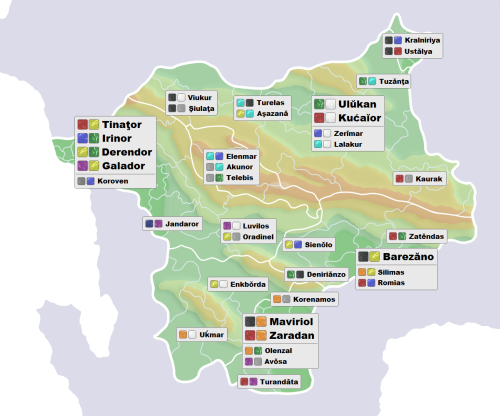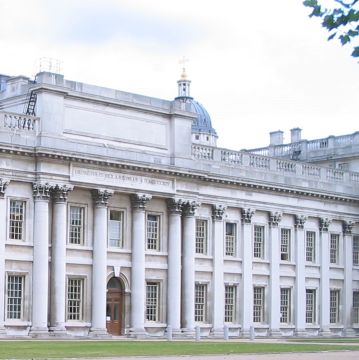
Houses of Trinia
The Houses of Trinia are a distinctive part of Trinian culture and politics, and no institutions found in other countries can be considered exactly equivalent to them. The Houses are essentially clans or tribes, with all citizens of Trinia being members of one, but their social and political role goes considerably beyond this. Understanding Trinia as a country and as a culture requires an understanding of the Houses and what they mean.

Map showing the seats of the thirty-seven Houses.
Houses with over a million members are shown in larger type.
[click map for larger view]
There are thirty-seven Houses in total. The largest has two and a half million members, while the smallest has two hundred thousand. The mean and median number of members are both around eight hundred thousand.
Origin of the Houses
In Trinian folklore, the Houses are often said to have been extended families, all descended from a single ancestor who gave the House its name. However, this explanation is not considered plausible by modern historians even in the case of the Tiŕănese, and certainly not in the case of the Quorians. Instead, it is believed that membership of a House originally entailed little more than being subject to a particular noble family. In its early days, Trinia was a chaotic mixture of feuding lords — there were few clear borders, meaning that no strong national identities could arise. The powerful noble families were more stable and enduring than the constantly shifting political entities that they tried to carve out, and because of this, people would identify themselves according to which of the lords they were ruled by, regardless of where the borders happened to be. Even after the area which now forms Trinia began to stabilise, the custom of associating oneself with one of the noble dynasties persisted. Thus, members of (for example) House Irinor were not necessarily related to the Irinor family, but rather, simply living under its banner.
There were once many more Houses than there are today — over five hundred House names have been recorded at various points of history, although they did not all exist at the same time. Houses generally rearranged themselves according to their ruling families, meaning that if families were joined through marriage or alliance, so too were the Houses. Over time, many of the smaller Houses were absorbed into larger ones — they sometimes retained a measure of independent identity, but seldom for more than a generation or two. Occasionally, new Houses have been formed, either by an equal merger (as opposed to when one is absorbed into another) or by a split. This was common in early times, but there have been no new Houses in the last few centuries.
Status and Role

The position of Houses in modern Trinian society is somewhat anomalous. They are important for several reasons, the most obvious being the fact that Houses play a central role in the Trinian political system, being the means through which Trinian citizens can exercise their democratic rights. Members of each House are entitled to elect a Lord or Lady, and the thirty-seven people so elected are, in essence, responsible for the government of Trinia — they select the Emperor from amongst themselves, and five of them will head the Ministries. In this respect, Houses can be compared to voting districts in other countries — just as the people of a different country might elect one representative per district, the people of Trinia elect one representative per House.
Houses also provide things for their members. For example, pensions are the responsibility of a person's House, and many Houses also provide certain types of insurance. Some act as investment funds for their members. They also have a role in the legal system — a House provides people with lawyers if they would otherwise be unrepresented, and supervise the release and reintegration into society of criminals who have served their time. In ancient times, a House would provide things such as training in crafts, accomodation when traveling, and legal representation, and there are sometimes relics of these traditions remaining today. Historically, all these things would have been paid for from the independent wealth of the House, but today, some are funded by the government — the House merely delivers the service on the government's behalf.
Beyond their functional role, the Houses are also the basis of strong social identities. Trinians are often proud of their House, in much the same way that citizens of other countries might be proud of their state, province, or hometown. One consequence is that most Trinian sports leagues are based on the Houses — for instance, there are no teams representing the cities of Zotĕa and Navrĭno, but rather, teams representing House Barezăno and House Zatĕndas.
Membership
At one point, the rules regarding House membership were strict — if a person was born into a particular House, then they remained part of that House for the rest of their life. Over time, however, these rules have been eroded, and it became possible for a person to transfer from one House to another. This process has been accelerated by the ease with which people can now move from one side of the country to another — Houses often have a strong geographic base, and as such, changing cities may well make it desirable to change House. Also, the fact that Houses gained reputations for certain things encouraged changes of allegiance — for example, House Silimas developed an extensive banking system and currently owns Trinia's third largest bank, meaning that large numbers of people working in that sector choose to join it — a far greater proportion of bankers belong to House Silimas than would be expected based on its share of the population.
Historically, each House was regarded as having distinctive political characteristics — for example, House Irinor and House Silimas were considered to be interested in acquiring wealth, House Barezăno was considered tactful and diplomatic, House Viukur was considered manipulative and ruthless, and House Korenamos was considered brave and militaristic. This reflected the sorts of attitudes and traditions allegedly found in the ruling family of each House. Today, however, these associations have mostly broken down — because each House is now democratic, the leadership of a House simply reflects the prevailing attitudes and circumstances of its people. The fact that each House has hundreds of thousands of members means that the membership of all Houses is necessarily quite diverse, stripping the various stereotypes of any validity they may once have had.
This does not mean that every House is interchangeable, however. It is still possible to observe certain characteristics or shared interests that may give rise to political leanings, such as:
- Geographic Basis — Although House membership is not technically based on geography, all Houses nevertheless have a part of the country in which their membership is concentrated. The increased mobility of the Trinian population in modern times may eventually erode this, but has not done so yet - some members of a House will leave their home city, but not a majority. Because of this, the Houses will predominantly reflect the political interests of the areas in which they are based, and will be influenced by regional cultures and traditions. House identities and local identities are sometimes indistinguishable.
- Socio-economic Basis — In some parts of the country, the membership of a House may be predominantly drawn from one particular socio-economic group. For example, one House might be largely middle class, while another might have a generally working class membership. The capital, Kurin, is often said to have this quality, although the differences between the Houses there are not actually as great as their public image suggests. In other parts of the country, such as Armenar, social class is not reflected in the House system at all. In modern times, when social mobility is much higher, any such distinction is growing less important, but it still exists. As an example, the fact that House Derendor's membership encompasses many of Kurin's poorer citizens is considered to give a distinct left-wing slant to its politics.
- History — In today's world, the impact of tradition on a House's modern politics is likely to be slight, but it may still be present, especially if it becomes a source of pride for the members of that House. For example, House Galador has been known for its defence of Trinian tradition, and even though its modern demographics give it no particular reason to continue this role, many House members are proud of it, and therefore emphasise it somewhat more than they otherwise might.
- Property — Historically, Houses were the largest economic actors in Trinia, owning most of the country's land and conducting most of its trade. In modern Trinia, the Houses are not as central as they used to be, but in many cases, they still have substantial financial holdings, and essentially act as investment funds for their members. For example, House Silimas still owns Trinia's third largest bank, House Irinor owns a shipping firm, House Luvilos owns a forestry company, and House Olenzal owns orchards. The particular financial interests of each House can give rise to certain political stances, as they will naturally wish to protect their interests.
House Colours
Houses identify themselves through a number of means, often varying between different parts of the country. The only symbols recognised across the whole of Trinia, however, are the colours associated with a particular House.
There are ten generally accepted colours in use. Some of these have traditionally been restricted to certain parts of the country — for example, the colour known in Trinian as tuani (a sort of pale blue or turquoise) was traditionally considered a shade of blue by the Quorians, but as a fully separate colour by the Tiŕănese, meaning that it is only used as a House colour in Tiŕănese areas. Likewise, orange has been mostly restricted to the south (having once been considered a variant of red elsewhere), and purple was originally found only in Vulni (which, possessing Trinia's only port, was most easily able to obtain the purple dyes necessary).
Each House has two colours, although historically, some had three, four, or even five. Older and larger Houses tended to have fewer colours, and as the number of Houses decreased, all the surviving smaller Houses eventually "promoted" themselves to two-colour status. The then-current colours did not actually provide enough combinations, prompting the reintroduction of the colour grey, which had fallen out of use — this is why grey is used by the smaller Houses and not the large ones. Other colours have dropped out of use entirely — there are no current Houses which use brown (once common across Trinia) or crimson (which was common in the south, but which has been turned into either red or purple over the years).
Lists of Houses
See: List of Trinian Houses, List of Defunct Trinian Houses